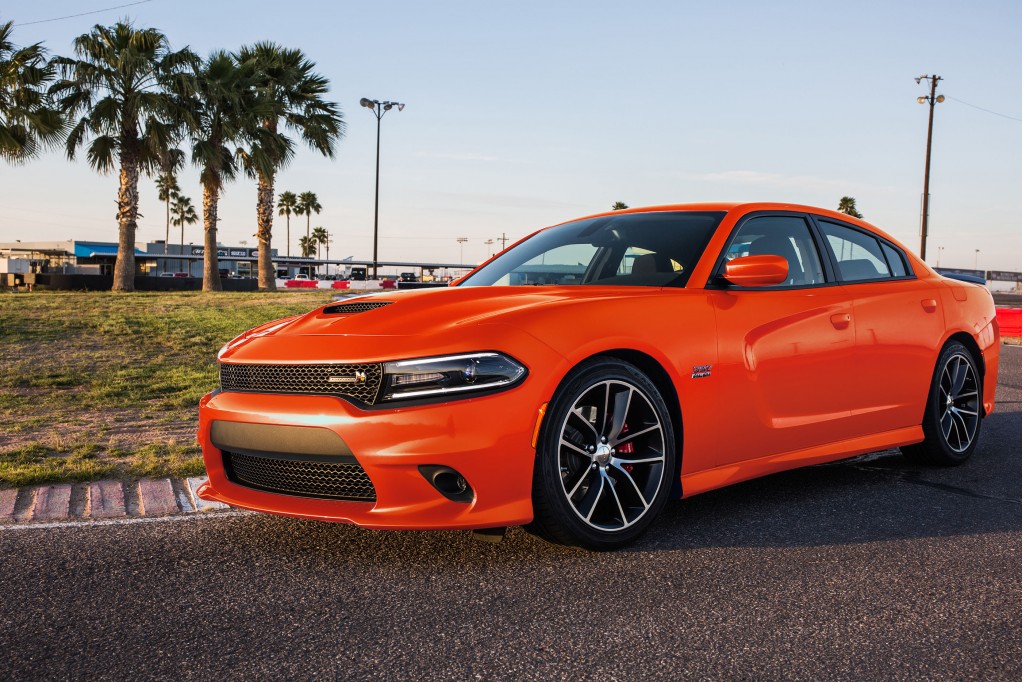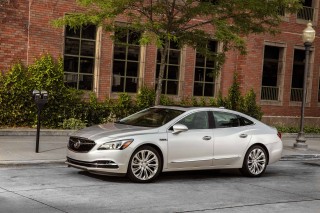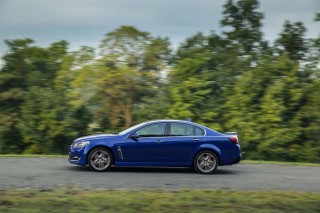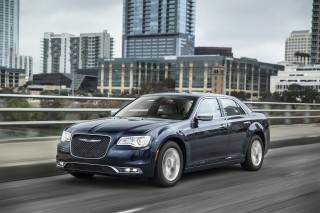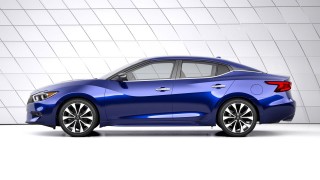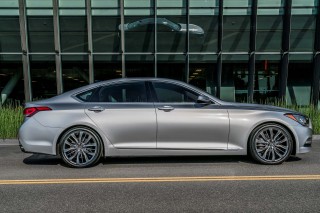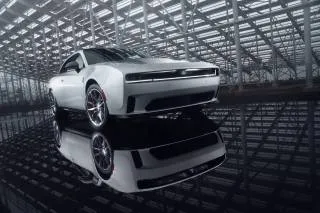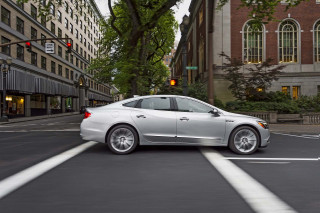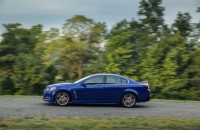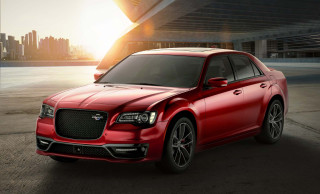Likes
- Rear-wheel drive V-8 performance at an affordable price
- Even the V-6 is impressive
- Terrific handling and ride quality
- Styling has aged well
Dislikes
- Heavy and thirsty with the V-8
- Interior can feel a little low buck against luxury rivals
- All-wheel drive only with V-6
Buying tip
features & specs
With standard rear-wheel drive and several flavors of V-6 and V-8 power on offer, the 2017 Dodge Charger is a large family sedan with the heart of a proper muscle car.
We've found the V-6 models to be very responsive with the Charger's standard 8-speed automatic transmission. In fact, the V-6 is really all that you'd need for keeping ahead of traffic, provided you're not going to miss having a V-8 under the hood. With any V-8, the 8-speed also allows for relaxed mid-throttle passing without having the engine belt out its full growl to Johnny Law.
If winter is a serious season where you live, you'll want to note that only the V-6 is available with all-wheel drive.
Even the Charger SE is a capable, composed handler in the tradition of European rear-wheel-drive sedans. A variety of suspension offerings tighten things up, but the full-blown Hellcat rides exceptionally stiffly. Then again, if you're buying a 707-horsepower car, you probably know what you're getting into.
2017 Dodge Charger comfort, safety, and features
Speaking of getting in and out, the big Charger is comfortable for four—although its rear seat is a little tighter than its enormous exterior proportions might suggest. Base Chargers are beautifully finished for the money, but those looking for more luxurious finishes should head over to their nearest Chrysler dealer to see that brand's Chrysler 300, which shares its platform and most of its powertrains (but not the high-performance versions) with the Charger.
The Charger SE includes some niceties like a touchscreen audio system, keyless ignition, and a power driver's seat. The SXT is more value-laden with heated seats, an 8.4-inch infotainment system with 911 assistance and an wi-fi hotspot (which requires a subscription), and 18-inch alloy wheels.
The R/T's big upgrade is its 5.7-liter V-8, but those looking for the most performance bang for the buck will like the R/T Scat Pack that combines the SRT-tuned 6.4-liter V-8 with a reasonable price point of about $41,000 including destination. The SRT 392 uses the same V-8 but lays on more luxury and capability with a three-mode adaptive suspension.
The 707-horsepower Hellcat, meanwhile, isn't for the uninitiated. It's more composed than its power may lead you to expect, and while it doesn't feel like a $70,000 car inside, that's easy to forgive once you open up its big, supercharged V-8. Good luck finding a place to test out its 204-mph top speed.
The Charger earned the highest five-star overall score in NHTSA safety testing. The IIHS gives it top "Good" ratings in all categories except the small front-overlap crash test, which means it doesn't qualify for Top Safety Pick honors. Buyers can increase the safety of their Chargers with such features as blind-spot monitors, rear cross-traffic alert, active lane control, forward collision warnings, and adaptive cruise control. Automatic emergency braking is bundled as part of the Technology Group on most Charger trim levels.
V-6 Chargers are EPA-rated at 19 mpg city, 30 highway, 23 combined with rear-wheel drive and 18/27/21 mpg with all-wheel drive. Opt for any of the V-8 models and you'll spend much more at the pump. The V-8-powered R/T models come with cylinder deactivation to save fuel in low load situations, but they still return a mediocre 19 combined. Not that fuel economy is important to someone buying a 707-horsepower car, but the Hellcat guzzles to the tune of 16 combined.
2017 Dodge Charger Styling
The Dodge Charger is racier than ever, but its basic shape definitely harks back to the '60s.
The Charger's Coke-bottle shape is right out of the '60s, but this big sedan steps into the modern era with the short front and rear overhangs and large wheels en vogue today. Its grille and other details are aligned with other Dodge models, including the Durango R/T that almost feels like a wagon version of the Charger.
We give this big sedan an 8 for the way its latest redesign has kept it fresh without diluting its racy attitude. (Read more about how we rate cars.)
A 2015 model year exterior refresh touched every body panel except the sedan's roof and the rear doors, giving it a more svelte look. Although it's the same length as before, it appears more compact and it presents a more aggressive face than ever before.
The Charger's side profile—if you ignore the dramatic, blunt front and rear ends—hasn't changed much in a decade, including its swollen rear fenders, high belt line, and hard-edged roof pillars. Yet its rear flanks appear less bulbous and smoother, with a more tapered wraparound to its big LED tail lamps.
Up front, the Charger's nose is low and its black grille and headlamp arrangement are as "Storm Trooper" as we've ever seen on a car. All versions of the Charger have their own distinct appearance touches, but the R/T may represent the best balance between aggression and restraint.
The Charger's "LED racetrack" rear lights are a signature feature that dates back to the 1960s (albeit without LEDs back then). Dodge uses light pipes to deliver a clean, continuous red outline on the trunk panel. The smooth rear bumper includes nicely integrated exhaust pipes.
Inside, as ever, you pay for this model's rather high window line with limited outward visibility compared to some other big sedans. The upright packaging yields plenty of head room all around, and wide, aggressively bolstered front seats are decidedly race-inspired.
Otherwise, the Charger's design is harmonious with the rest of the models in the Dodge and Jeep lineups, with subtle surfacing, contrasting matte metallic framing accents, and plenty of soft-touch materials. There's a 7.0-inch display screen in the instrument cluster, while the center stack in all but the SE includes an 8.4-inch touchscreen.
2017 Dodge Charger Performance
No version of the Dodge Charger is a slouch—and the Hellcat is unmatched.
You don't have to spend big bucks to tap into the 2017 Dodge Charger's performance heritage. From the workaday V-6 all the way up to the exotic-level Charger SRT Hellcat, this lineup delivers even more performance than the sedans' sinewy styling suggests.
More importantly, the Charger strikes a brilliant balance between performance and day-to-day livability, something that helps it score an impressive 9 out of 10. (Read more about how we rate cars.)
The SE and SXT's 292 horsepower 3.6-liter V-6 delivers 260 pound-feet of torque, and at 30 mpg highway, it is the fuel economy champ. Add the Rallye Group to the SXT, which includes a cold air intake, a modified exhaust, and some software tweaks, and those figures climb to 300 horsepower and 264 pound-feet.
Only the Charger V-6 offers a choice between rear- and all-wheel drive; V-8s are rear-drive only. However, all Chargers regardless of engine use a superb 8-speed automatic transmission let down only by a balky gear lever.
If it's a V-8 you're after, the Charger offers three options: Hot, hotter, and, well, ghost pepper.
To start, there's the R/T with its 5.7-liter Hemi V-8 rated at 370 horsepower and 395 pound-feet of torque. Cylinder deactivation helps it guzzle a little less than you might expect.
Above that, the R/T Scat Pack and SRT 392 utilize a 6.4-liter V-8 rated at 485 horsepower. The Scat Pack makes the 6.4 available at an entry price of a hair over $40,000. The 6.4-liter V-8 is much stronger than the 5.7, delivering a 0 to 60 mph sprint in the mid four-second range.
The undisputed king of the lineup (if not the King of Detroit) is the Charger SRT Hellcat. It has the same 707-horsepower supercharged 6.2-liter V-8 as the Challenger SRT Hellcat, but it accelerates even quicker than the Challenger Hellcat (0 to 60 mph in just 3.7 seconds). And its top speed is a holy-rolling 204 mph, provided you can find a place to legally stretch its legs.
2017 Dodge Charger Comfort & Quality
The Charger is roomy, but its interior can feel a little low buck in places.
The Dodge Charger's interior is simple, but offers a fairly high level of technology. Given that there's a $40,000-plus gap between the base SE and a fully loaded SRT Hellcat, we think Dodge did a pretty good job overall keeping all models feel about right for the money, which is why it rates as a 7 out of 10 for comfort and quality. (Read more about how we rate cars.)
For 2017, one addition is that SE, SXT, and R/T models are now available with the retro-inspired houndstooth cloth upholstery (which can be heated). Dodge makes good use of corporate parent Fiat Chrysler's 8.4-inch touchscreen infotainment. A few upgrades for 2017 are promised to make things a little faster, while Apple CarPlay and Android auto are newly available.
All Chargers are commendably quiet, although the V-8 makes its presence known via a throaty exhaust rumble that most Charger buyers will probably find endearing.
Given its large footprint, it isn't a big surprise that the Charger is plenty roomy inside. Its rear seat can feel a little more cramped than some rivals, but it still offers decent stretch out space.
In general, the Charger is only let down by some dashboard, center console, and door materials that don't feel quite as appropriate at, say, $55,000 as they do at $35,000. But you're paying for space and pace as much as you are luxury with the Charger, and upper trims compensate somewhat with luxurious nappa leather upholstery.
2017 Dodge Charger Safety
The Charger scores well overall and offers affordable safety tech, but its IIHS small-overlap test results aren't great.
The 2017 Dodge Charger has mostly performed well in crash tests and its standard and optional safety equipment is available at a relatively accessible price point.
However, the IIHS conducted its more challenging small-overlap test and rated the Charger with a "Marginal" rating, and a rearview camera isn't standard, which knocks this big sedan down to 5 out of 10 for safety. (Read more about how we rate cars.)
Standard safety features include full-length side-curtain airbags, a driver's side knee bag, and front-seat active head restraints. Rear park assist and a rearview camera are standard on the R/T Scat Pack model and above, but optional on lower trim levels. Rear cross-traffic alert is standard on the SRT 392 and SRT Hellcat, and blind-spot monitors are standard on the Hellcat, features that are optional on lower trims.
More advanced safety features are bundled with the Technology Group, which includes lane-departure warning with active lane control, forward collision warning, adaptive cruise control, and automatic emergency braking.
2017 Dodge Charger Features
Dodge offers an especially wide range of Chargers, and some big infotainment upgrades for 2017 help things out.
A wide range of trim levels—and engines, of course—means that there is a Dodge Charger for just about everyone.
The lineup starts with the modestly-equipped SE aimed at price-conscious buyers and vaults through SXT, R/T, R/T Scat Pack, SRT 392, and finally arrives at the SRT Hellcat. Overall there's about a $40,000 spread between them, but none are lacking for features or value, which is why the Charger scores an 8 out of 10. (Read more about how we rate cars.)
The breakdown
The Charger SE isn't sparsely equipped, but it's not exactly lavish, either. Alloy wheels, the expected power accessories including a power driver's seat, and a small touchscreen display help it feel with the times. The SXT is better packaged with an 8.4-inch touchscreen that has been upgraded with faster-performing software for 2017, as well as heated seats, 18-inch alloy wheels, remote start, two USB ports, and a better stereo system.
SXTs are available with important collision avoiding tech packaged in the Technology group, which requires adding a luxo-laden Plus Group with HID headlights, a heated steering wheel, memory for the driver's seat, leather trim, and a backup camera. All told, you're still around $37,000, which isn't out of line for this level of equipment and power.
Both the SE and SXT offer a choice between rear- and all-wheel drive, something relegated to upper trim levels in some rivals.
But if it's performance you're after, the R/T delivers not only a V-8 but a sport suspension and performance tires. The R/T Scat Pack builds on that with an SRT-tuned 6.4-liter V-8, Brembo four-piston brakes, and Bilstein dampers, but few additional luxury features. It's a delightful throwback to muscle cars of yore without feeling overwhelmingly heritage-sappy.
The SRT 392 gets a power passenger seat and heated rear seats wrapped in nicer leather, plus a Brembo six-piston ultra-high performance brake package, navigation, and SiriusXM TravelLink and Traffic.
In addition to its very significant engine upgrade, the Charger SRT Hellcat gets a Drive Modes feature, allowing Sport, Track, Default, and Eco settings that together affect transmission shift points, paddle-shifter behavior, traction controls, and suspension. They can also limit power; the Charger Hellcat includes a red and a black key fob, with the black one offering reduced engine output down to a mere 500 horsepower. There's also a Valet Mode, which is a rather crucial feature. A 900-watt, 18-speaker Harman Kardon premium audio system is standard on the Hellcat (optional on the SRT 392), as are a revised-for-2017 flat-bottom heated steering wheel, heated and cooled front seats, and heated rear seats. The seats are also upgraded, with more cushioning and bolstering, and there's also a special T-handle shifter.
Exclusive to the SRT 392 and Hellcat models is a three-mode adaptive damping system with Auto, Sport, and Track modes, as well as a loud active exhaust system and special apps that let drivers time their 0-60 sprints and view their mid-corner g-forces. Both the SRT 392 and the Hellcat offer Z-rated Pirelli P Zero performance tires that allow drivers to get the most out of this chassis and powertrain but are not advisable for winter.
Throughout the lineup there are a half dozen 20-inch alloy wheel designs that have mostly been redesigned for 2017, as well as a host of "heritage" color choices that allow buyers to ensure their Chargers don't look like anyone else's.
You can easily add many thousands of dollars to the bottom line price of a Charger if you get carried away with options, and many of them are placed together in large packages.
2017 Dodge Charger Fuel Economy
The V-6 Charger is surprisingly thrifty, but V-8s guzzle about like you'd expect.
The trade-off for performance is fuel economy on the Charger; for every step up in power, you'll lose some miles per gallon—and the step from V-6 to V-8 models is particularly notable.
But if you stick with the Charger V-6, you'll see 19 mpg city, 30 highway, 23 combined with rear-wheel drive thanks to the slick 8-speed automatic. Some rivals are better, but the Charger isn't far off the mark, which helps it net a 6 out of 10. (Read more about how we rate cars.)
Select all-wheel drive and those figures drop to 18/27/21 mpg despite a system designed to automatically disconnect the front axle when extra traction isn't essential. The V-8s are much more interested in drinking Premium unleaded: from 16/25/19 mpg for the R/T down to a thirsty 13/22/16 mpg for the SRT Hellcat.
Then again, 22 mpg on the highway for a 707 horsepower car isn't all that bad.
